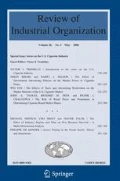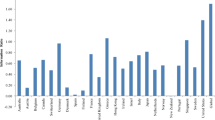Abstract
This article discusses the empirical challenges that researchers face when demonstrating the existence and effects of resale price maintenance (RPM). We outline three approaches for finding price effects of RPM and the corresponding hurdles in data and methodology. We show that the quantity test that was suggested by Posner (Univ Chic Law Rev 45(1):1–20, 1977; Univ Chic Law Rev 48:6–26, 1981) does not identify the change to welfare when demand-enhancing effects are considered generally. Finally, we present some solutions to the challenge of identifying welfare effects, and we suggest guidelines for future research.
Similar content being viewed by others
Notes
Leegin Creative Leather Products, Inc. v. PSKS, Inc., 551 U.S. 877 (2007).
See Continental T.V., Inc. v. GTE Sylvania Inc., 433 U.S. 36 (1977).
See United States v. Kellogg Toasted Corn Flake Co., 222 Fed. 725 (1915).
See United States v. Colgate & Co., 250 U.S. 300 (1919).
Adolph Coors Co. v. FTC, 497 F.2d 1178 (1974), 419 U.S. 1105 (1975).
See Monsanto Co. v. Spray-Rite Service Corp., 104 S. Ct. 1464 (1984).
See Ippolito (1991).
This may be due to a combination of highly elastic consumers and left-digit bias. Left-digit bias is a concept in behavioral economics and experimental psychology that refers to the tendency to focus on the left-most digit of a number while partially ignoring other digits. See Lacetera et al. (2012), Korvorst and Damian (2008) and Poltrock and Schwartz (1984).
Specifically, the authors suggest that antitrust enforcement policy should be guided by “inferences about the competitive effects of the restraint from a natural experiment. The quality of the experiment and how closely it mimics the effect of the restraint would be issues for the court or decision-maker to resolve”.
That is not to claim that retailers have nothing to lose. Our interviews with retailers indicate that those that threaten or pursue litigation risk losing their relationship with manufacturers.
See Elzinga and Mills (2010).
See Ippolito and Overstreet (1996).
Any transformation of the demand curve that is composed of a shift and a rotation can be decomposed into these two transformations.
There is a well-known result that a monopolist will not change its price when the demand curve rotates about a fixed point on the price axis and marginal costs are constant. This result is applicable when demand is linear. When the demand curve is non-linear, a monopolist may wish to raise or lower its price. The price increase may be great enough to lower net consumer surplus, after accounting for the demand-enhancing rotation.
Other demand considerations, such as dynamics, make the analysis more complex. For example, Aviv et al. (2016) show that “a higher price and lower output of a limited lifetime product can be welfare-improving if they result from a policy that leads to an intertemporal redistribution of demand,” such as when retailers implement a most-favored-customer clause.
See, e.g., MacKay and Smith (2014).
For a discussion of minimum RPM as a self-enforcing contract, see Klein and Murphy (1997).
The Sony BRAVIA model KDL-32BX300 was released March 2010; the KDL-32BX320 was released in 2011; and the KDL-32BX330 was released in 2012, around the time Sony began enforcing minimum RPM. See Ann Zimmerman, “Sony, Samsung Rein In Retailers’ Discounts on TVs,” The Wall Street Journal, May 23, 2012. Retrieved August 12, 2016, from http://www.wsj.com/articles/SB10001424052702304791704577420383631021786.
This may come as no surprise to those who recall that, not long ago, Best Buy—a store that primarily sells durable goods with high search costs—was said to have the worst CEO in the world. See Louis Lavelle, “The Worst CEOs of 2012,” Bloomberg, December 13, 2012. Retrieved August 12, 2016, from http://www.bloomberg.com/news/articles/2012-12-13/the-worst-ceos-of-2012.
References
Aviv, Y., Bazhanov, A., Levin, Y., & Nediak, M. (2016). Quantity competition under resale price maintenance when most favored customers are strategic. MPRA working paper 72011.
Bailey, E. M., & Leonard, G. K. (2010). Minimum resale price maintenance: Some empirical evidence from Maryland. The BE Journal of Economic Analysis and Policy, 10(1), 1–8.
Baker, J. B. (2015). Taking the error out of ‘error cost’ analysis: What’s wrong with antitrust’s right. Antitrust Law Journal, 80(1), 1–38.
Cooper, J. C., Froeb, L. M., O’Brien, D., & Vita, M. G. (2005). Vertical antitrust policy as a problem of inference. International Journal of Industrial Organization, 23(7), 639–664.
Elzinga, K. G., & Mills, D. E. (2008). The economics of resale price maintenance. In K. G. Elzinga & D. E. Mills (Eds.), Issues in competition law and policy (Vol. 3, pp. 1841–1858). Chicago: ABA Section of Antitrust Law.
Elzinga, K. G., & Mills, D. E. (2010). Leegin and procompetitive resale price maintenance. The Antitrust Bulletin, 55(2), 349–379.
Gundlach, G. T. (2014). Resale price maintenance: A review and call for research. American Antitrust Institute working paper 14-03.
Ippolito, P. M. (1991). Resale price maintenance: Empirical evidence from litigation. Journal of Law and Economics, 34(2), 263–294.
Ippolito, P. M., & Overstreet, T. R. (1996). Resale price maintenance: An economic assessment of the Federal Trade Commission’s case against the corning glass works. Journal of Law and Economics, 39(1), 285–328.
Klein, B., & Murphy, K. M. (1997). Vertical integration as a self-enforcing contractual arrangement. The American Economic Review, 87(2), 415–420.
Korvorst, M., & Damian, M. F. (2008). The differential influence of decades and units on multidigit number comparison. The Quarterly Journal of Experimental Psychology, 61(8), 1250–1264.
Lacetera, N., Pope, D. G., & Sydnor, J. R. (2012). Heuristic thinking and limited attention in the car market. The American Economic Review, 102(5), 2206–2236.
Lach, S., & Tsiddon, D. (1992). The behavior of prices and inflation: An empirical analysis of disaggregated price data. Journal of Political Economy, 100(2), 349–89.
Lafontaine, F., & Slade, M. (2013). Inter-firm contracts. In R. Gibbons & J. Roberts (Eds.), The handbook of organizational economics (pp. 958–1013). Princeton: Princeton University Press.
Lyons, B. R. (1996). Empirical relevance of efficient contract theory: Inter-firm contracts. Oxford Review of Economic Policy, 12(4), 27–52.
MacKay, A. & Smith, D. A. (2014). The empirical effects of minimum resale price maintenance. Available at SSRN 2513533.
Marvel, H. P., & McCafferty, S. (1984). Resale price maintenance and quality certification. The RAND Journal of Economics, 15, 346–359.
Mathewson, F., & Winter, R. (1998). The law and economics of resale price maintenance. Review of Industrial Organization, 13(1), 57–84.
Overstreet, T. R. (1983). Resale price maintenance: Economic theories and empirical evidence. Washington, DC: Federal Trade Commission.
Pitofsky, R. (1982). In defense of discounters: The no-frills case for a per se rule against vertical price fixing. Georgetown Law Review, 71, 1487–1635.
Poltrock, S. E., & Schwartz, D. R. (1984). Comparative judgments of multidigit numbers. Journal of Experimental Psychology: Learning, Memory, and Cognition, 10(1), 32–35.
Posner, R. A. (1977). The rule of reason and the economic approach: Reflections on the Sylvania decision. The University of Chicago Law Review, 45(1), 1–20.
Posner, R. A. (1981). The next step in the antitrust treatment of restricted distribution: Per se legality. University of Chicago Law Review, 48, 6–26.
Rátfai, A. (2007). The frequency and size of price adjustment: Microeconomic evidence. Managerial and Decision Economics, 28(7), 751–762.
Author information
Authors and Affiliations
Corresponding author
Rights and permissions
About this article
Cite this article
MacKay, A., Smith, D.A. Challenges for Empirical Research on RPM. Rev Ind Organ 50, 209–220 (2017). https://doi.org/10.1007/s11151-016-9562-8
Published:
Issue Date:
DOI: https://doi.org/10.1007/s11151-016-9562-8




